Strategic Supply Chain Management: A TCE and RBV Perspective
VerifiedAdded on 2023/06/12
|18
|6675
|169
Essay
AI Summary
This essay provides an overview of Supply Chain Management (SCM) and draws from theoretical contributions, focusing on Transaction Cost Economics (TCE) and the Resource-Based View (RBV). It begins by defining SCM and highlighting the importance of theoretical contributions such as RBV, TCE, stakeholder theory, and institutional theory. The paper then delves into TCE, outlining its concepts, constituent elements like bounded rationality and opportunism, and various contracting mechanisms supported by the theory. It contrasts TCE with the RBV of the firm, explaining the main elements and arguments of RBV. Furthermore, the essay defines outsourcing, differentiates it from offshoring, and discusses the benefits and disadvantages of outsourcing in the context of supply chain management, referencing relevant theories. The analysis aims to provide a comprehensive understanding of these theories and their practical implications in strategic supply chain decisions.
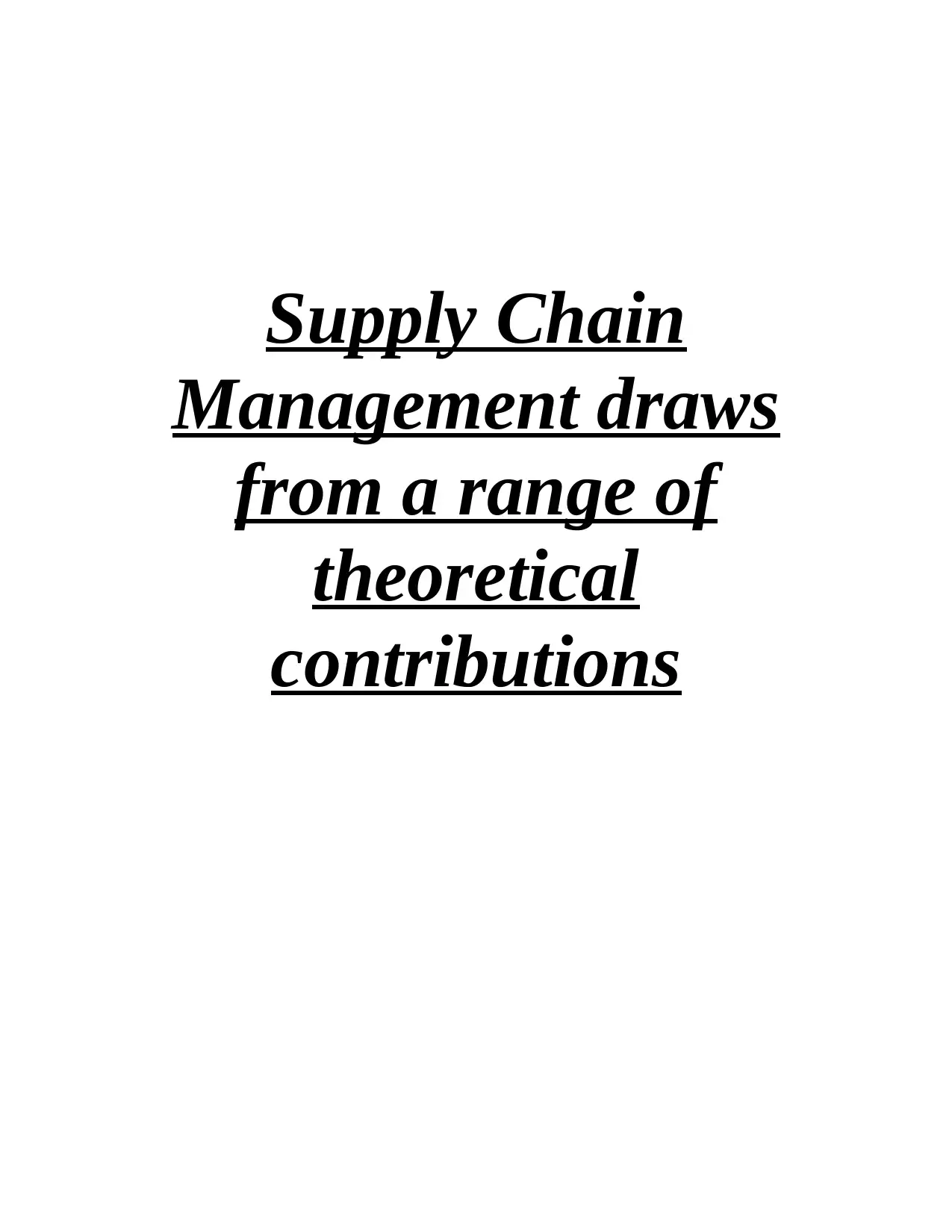
Supply Chain
Management draws
from a range of
theoretical
contributions
Management draws
from a range of
theoretical
contributions
Paraphrase This Document
Need a fresh take? Get an instant paraphrase of this document with our AI Paraphraser
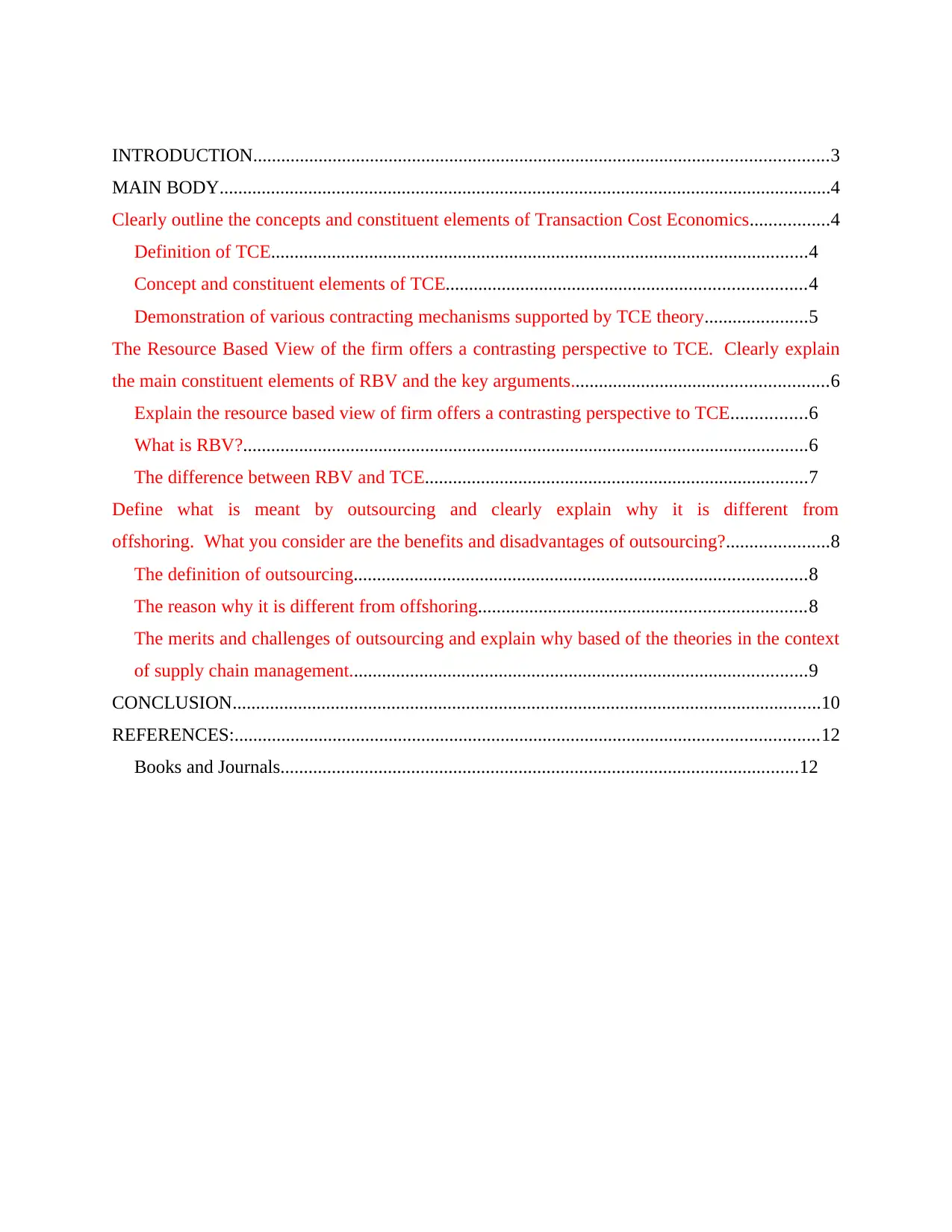
INTRODUCTION...........................................................................................................................3
MAIN BODY...................................................................................................................................4
Clearly outline the concepts and constituent elements of Transaction Cost Economics.................4
Definition of TCE...................................................................................................................4
Concept and constituent elements of TCE.............................................................................4
Demonstration of various contracting mechanisms supported by TCE theory......................5
The Resource Based View of the firm offers a contrasting perspective to TCE. Clearly explain
the main constituent elements of RBV and the key arguments.......................................................6
Explain the resource based view of firm offers a contrasting perspective to TCE................6
What is RBV?.........................................................................................................................6
The difference between RBV and TCE..................................................................................7
Define what is meant by outsourcing and clearly explain why it is different from
offshoring. What you consider are the benefits and disadvantages of outsourcing?......................8
The definition of outsourcing.................................................................................................8
The reason why it is different from offshoring......................................................................8
The merits and challenges of outsourcing and explain why based of the theories in the context
of supply chain management..................................................................................................9
CONCLUSION..............................................................................................................................10
REFERENCES:.............................................................................................................................12
Books and Journals...............................................................................................................12
MAIN BODY...................................................................................................................................4
Clearly outline the concepts and constituent elements of Transaction Cost Economics.................4
Definition of TCE...................................................................................................................4
Concept and constituent elements of TCE.............................................................................4
Demonstration of various contracting mechanisms supported by TCE theory......................5
The Resource Based View of the firm offers a contrasting perspective to TCE. Clearly explain
the main constituent elements of RBV and the key arguments.......................................................6
Explain the resource based view of firm offers a contrasting perspective to TCE................6
What is RBV?.........................................................................................................................6
The difference between RBV and TCE..................................................................................7
Define what is meant by outsourcing and clearly explain why it is different from
offshoring. What you consider are the benefits and disadvantages of outsourcing?......................8
The definition of outsourcing.................................................................................................8
The reason why it is different from offshoring......................................................................8
The merits and challenges of outsourcing and explain why based of the theories in the context
of supply chain management..................................................................................................9
CONCLUSION..............................................................................................................................10
REFERENCES:.............................................................................................................................12
Books and Journals...............................................................................................................12
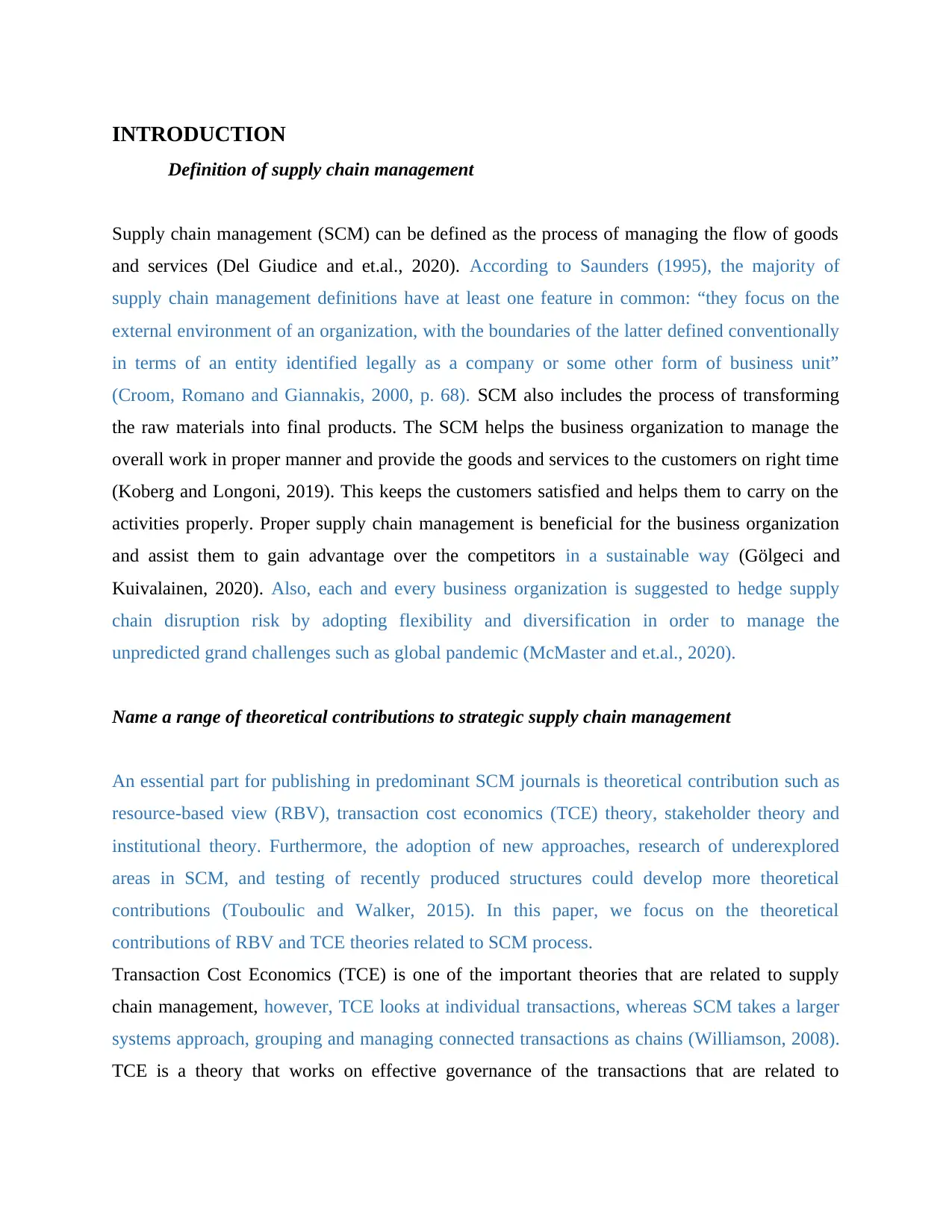
INTRODUCTION
Definition of supply chain management
Supply chain management (SCM) can be defined as the process of managing the flow of goods
and services (Del Giudice and et.al., 2020). According to Saunders (1995), the majority of
supply chain management definitions have at least one feature in common: “they focus on the
external environment of an organization, with the boundaries of the latter defined conventionally
in terms of an entity identified legally as a company or some other form of business unit”
(Croom, Romano and Giannakis, 2000, p. 68). SCM also includes the process of transforming
the raw materials into final products. The SCM helps the business organization to manage the
overall work in proper manner and provide the goods and services to the customers on right time
(Koberg and Longoni, 2019). This keeps the customers satisfied and helps them to carry on the
activities properly. Proper supply chain management is beneficial for the business organization
and assist them to gain advantage over the competitors in a sustainable way (Gölgeci and
Kuivalainen, 2020). Also, each and every business organization is suggested to hedge supply
chain disruption risk by adopting flexibility and diversification in order to manage the
unpredicted grand challenges such as global pandemic (McMaster and et.al., 2020).
Name a range of theoretical contributions to strategic supply chain management
An essential part for publishing in predominant SCM journals is theoretical contribution such as
resource-based view (RBV), transaction cost economics (TCE) theory, stakeholder theory and
institutional theory. Furthermore, the adoption of new approaches, research of underexplored
areas in SCM, and testing of recently produced structures could develop more theoretical
contributions (Touboulic and Walker, 2015). In this paper, we focus on the theoretical
contributions of RBV and TCE theories related to SCM process.
Transaction Cost Economics (TCE) is one of the important theories that are related to supply
chain management, however, TCE looks at individual transactions, whereas SCM takes a larger
systems approach, grouping and managing connected transactions as chains (Williamson, 2008).
TCE is a theory that works on effective governance of the transactions that are related to
Definition of supply chain management
Supply chain management (SCM) can be defined as the process of managing the flow of goods
and services (Del Giudice and et.al., 2020). According to Saunders (1995), the majority of
supply chain management definitions have at least one feature in common: “they focus on the
external environment of an organization, with the boundaries of the latter defined conventionally
in terms of an entity identified legally as a company or some other form of business unit”
(Croom, Romano and Giannakis, 2000, p. 68). SCM also includes the process of transforming
the raw materials into final products. The SCM helps the business organization to manage the
overall work in proper manner and provide the goods and services to the customers on right time
(Koberg and Longoni, 2019). This keeps the customers satisfied and helps them to carry on the
activities properly. Proper supply chain management is beneficial for the business organization
and assist them to gain advantage over the competitors in a sustainable way (Gölgeci and
Kuivalainen, 2020). Also, each and every business organization is suggested to hedge supply
chain disruption risk by adopting flexibility and diversification in order to manage the
unpredicted grand challenges such as global pandemic (McMaster and et.al., 2020).
Name a range of theoretical contributions to strategic supply chain management
An essential part for publishing in predominant SCM journals is theoretical contribution such as
resource-based view (RBV), transaction cost economics (TCE) theory, stakeholder theory and
institutional theory. Furthermore, the adoption of new approaches, research of underexplored
areas in SCM, and testing of recently produced structures could develop more theoretical
contributions (Touboulic and Walker, 2015). In this paper, we focus on the theoretical
contributions of RBV and TCE theories related to SCM process.
Transaction Cost Economics (TCE) is one of the important theories that are related to supply
chain management, however, TCE looks at individual transactions, whereas SCM takes a larger
systems approach, grouping and managing connected transactions as chains (Williamson, 2008).
TCE is a theory that works on effective governance of the transactions that are related to
⊘ This is a preview!⊘
Do you want full access?
Subscribe today to unlock all pages.

Trusted by 1+ million students worldwide
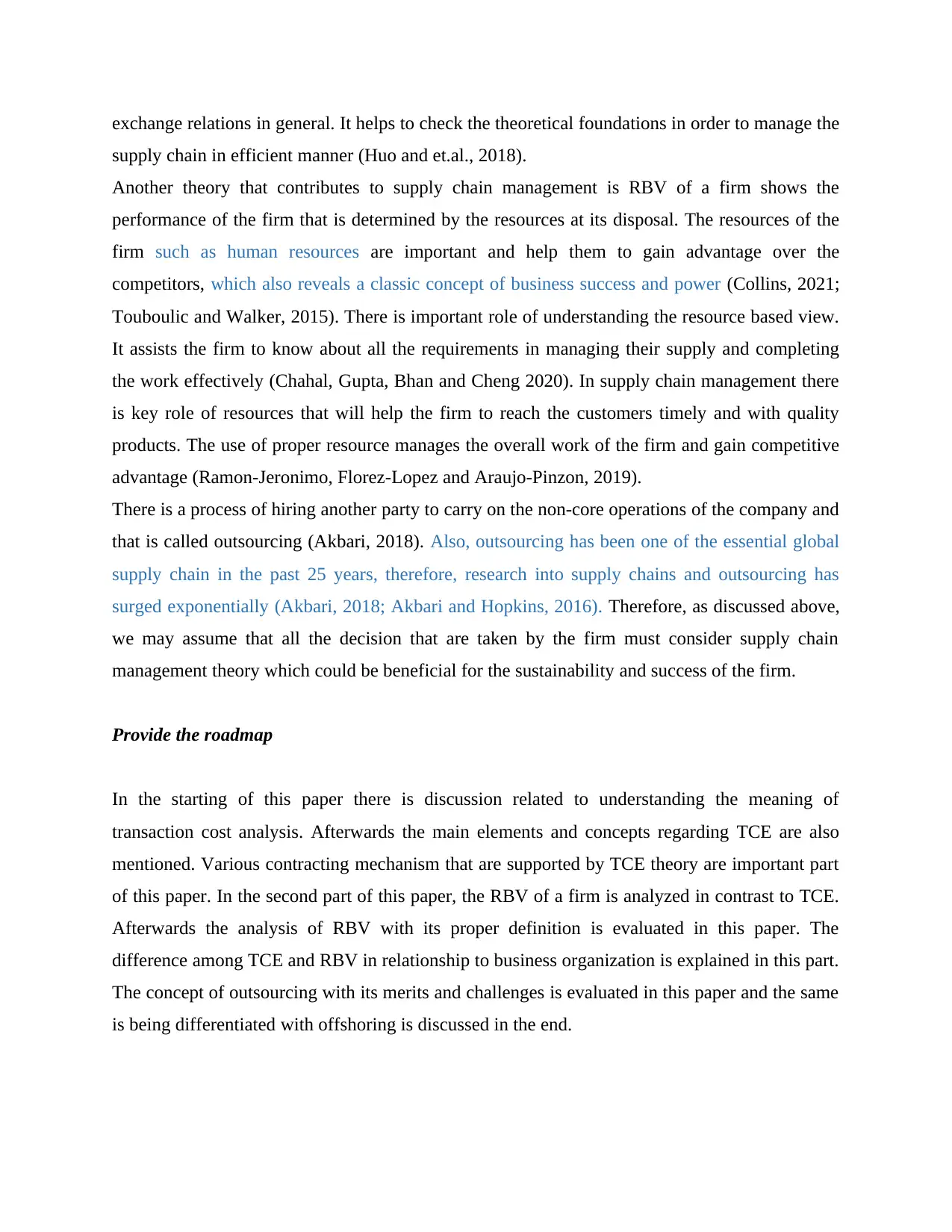
exchange relations in general. It helps to check the theoretical foundations in order to manage the
supply chain in efficient manner (Huo and et.al., 2018).
Another theory that contributes to supply chain management is RBV of a firm shows the
performance of the firm that is determined by the resources at its disposal. The resources of the
firm such as human resources are important and help them to gain advantage over the
competitors, which also reveals a classic concept of business success and power (Collins, 2021;
Touboulic and Walker, 2015). There is important role of understanding the resource based view.
It assists the firm to know about all the requirements in managing their supply and completing
the work effectively (Chahal, Gupta, Bhan and Cheng 2020). In supply chain management there
is key role of resources that will help the firm to reach the customers timely and with quality
products. The use of proper resource manages the overall work of the firm and gain competitive
advantage (Ramon-Jeronimo, Florez-Lopez and Araujo-Pinzon, 2019).
There is a process of hiring another party to carry on the non-core operations of the company and
that is called outsourcing (Akbari, 2018). Also, outsourcing has been one of the essential global
supply chain in the past 25 years, therefore, research into supply chains and outsourcing has
surged exponentially (Akbari, 2018; Akbari and Hopkins, 2016). Therefore, as discussed above,
we may assume that all the decision that are taken by the firm must consider supply chain
management theory which could be beneficial for the sustainability and success of the firm.
Provide the roadmap
In the starting of this paper there is discussion related to understanding the meaning of
transaction cost analysis. Afterwards the main elements and concepts regarding TCE are also
mentioned. Various contracting mechanism that are supported by TCE theory are important part
of this paper. In the second part of this paper, the RBV of a firm is analyzed in contrast to TCE.
Afterwards the analysis of RBV with its proper definition is evaluated in this paper. The
difference among TCE and RBV in relationship to business organization is explained in this part.
The concept of outsourcing with its merits and challenges is evaluated in this paper and the same
is being differentiated with offshoring is discussed in the end.
supply chain in efficient manner (Huo and et.al., 2018).
Another theory that contributes to supply chain management is RBV of a firm shows the
performance of the firm that is determined by the resources at its disposal. The resources of the
firm such as human resources are important and help them to gain advantage over the
competitors, which also reveals a classic concept of business success and power (Collins, 2021;
Touboulic and Walker, 2015). There is important role of understanding the resource based view.
It assists the firm to know about all the requirements in managing their supply and completing
the work effectively (Chahal, Gupta, Bhan and Cheng 2020). In supply chain management there
is key role of resources that will help the firm to reach the customers timely and with quality
products. The use of proper resource manages the overall work of the firm and gain competitive
advantage (Ramon-Jeronimo, Florez-Lopez and Araujo-Pinzon, 2019).
There is a process of hiring another party to carry on the non-core operations of the company and
that is called outsourcing (Akbari, 2018). Also, outsourcing has been one of the essential global
supply chain in the past 25 years, therefore, research into supply chains and outsourcing has
surged exponentially (Akbari, 2018; Akbari and Hopkins, 2016). Therefore, as discussed above,
we may assume that all the decision that are taken by the firm must consider supply chain
management theory which could be beneficial for the sustainability and success of the firm.
Provide the roadmap
In the starting of this paper there is discussion related to understanding the meaning of
transaction cost analysis. Afterwards the main elements and concepts regarding TCE are also
mentioned. Various contracting mechanism that are supported by TCE theory are important part
of this paper. In the second part of this paper, the RBV of a firm is analyzed in contrast to TCE.
Afterwards the analysis of RBV with its proper definition is evaluated in this paper. The
difference among TCE and RBV in relationship to business organization is explained in this part.
The concept of outsourcing with its merits and challenges is evaluated in this paper and the same
is being differentiated with offshoring is discussed in the end.
Paraphrase This Document
Need a fresh take? Get an instant paraphrase of this document with our AI Paraphraser
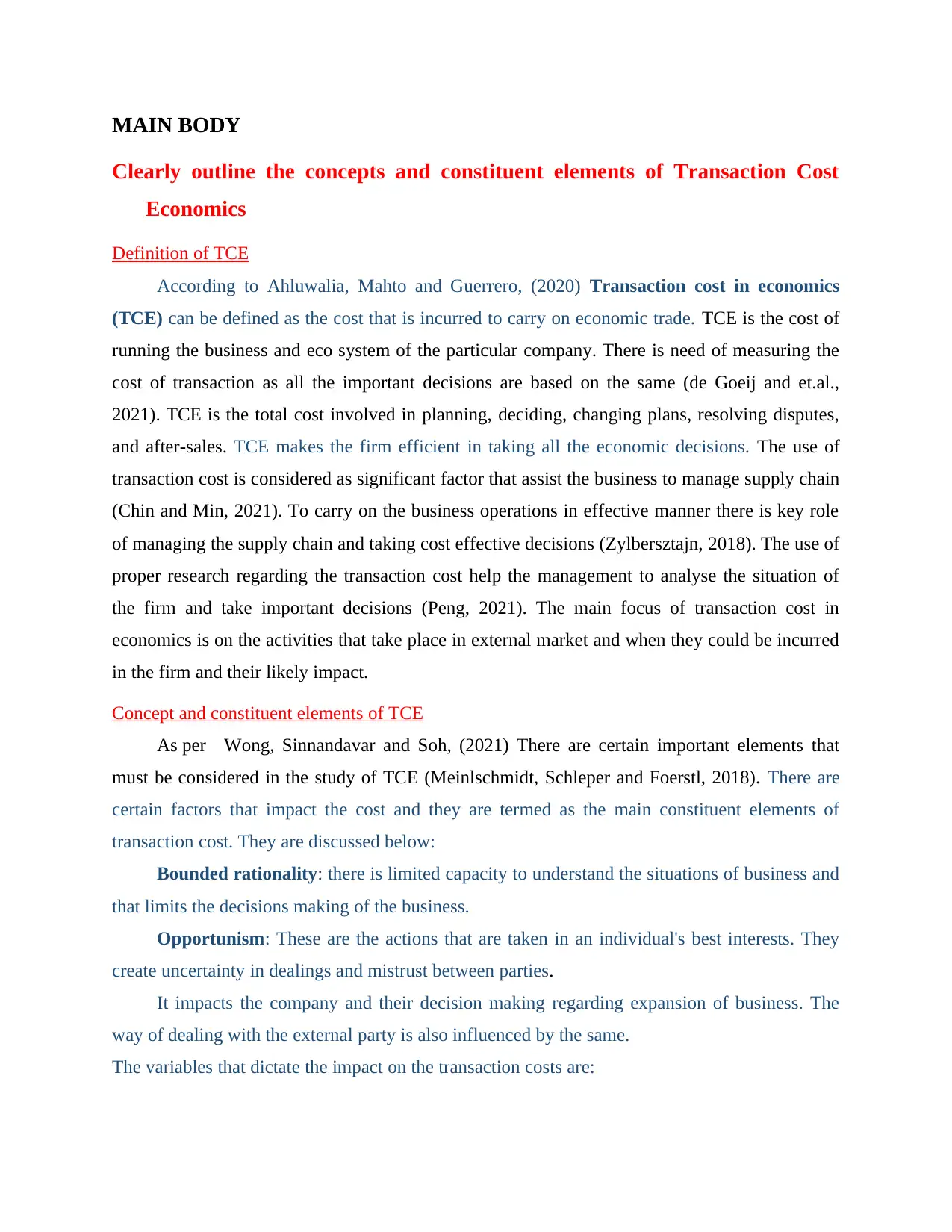
MAIN BODY
Clearly outline the concepts and constituent elements of Transaction Cost
Economics
Definition of TCE
According to Ahluwalia, Mahto and Guerrero, (2020) Transaction cost in economics
(TCE) can be defined as the cost that is incurred to carry on economic trade. TCE is the cost of
running the business and eco system of the particular company. There is need of measuring the
cost of transaction as all the important decisions are based on the same (de Goeij and et.al.,
2021). TCE is the total cost involved in planning, deciding, changing plans, resolving disputes,
and after-sales. TCE makes the firm efficient in taking all the economic decisions. The use of
transaction cost is considered as significant factor that assist the business to manage supply chain
(Chin and Min, 2021). To carry on the business operations in effective manner there is key role
of managing the supply chain and taking cost effective decisions (Zylbersztajn, 2018). The use of
proper research regarding the transaction cost help the management to analyse the situation of
the firm and take important decisions (Peng, 2021). The main focus of transaction cost in
economics is on the activities that take place in external market and when they could be incurred
in the firm and their likely impact.
Concept and constituent elements of TCE
As per Wong, Sinnandavar and Soh, (2021) There are certain important elements that
must be considered in the study of TCE (Meinlschmidt, Schleper and Foerstl, 2018). There are
certain factors that impact the cost and they are termed as the main constituent elements of
transaction cost. They are discussed below:
Bounded rationality: there is limited capacity to understand the situations of business and
that limits the decisions making of the business.
Opportunism: These are the actions that are taken in an individual's best interests. They
create uncertainty in dealings and mistrust between parties.
It impacts the company and their decision making regarding expansion of business. The
way of dealing with the external party is also influenced by the same.
The variables that dictate the impact on the transaction costs are:
Clearly outline the concepts and constituent elements of Transaction Cost
Economics
Definition of TCE
According to Ahluwalia, Mahto and Guerrero, (2020) Transaction cost in economics
(TCE) can be defined as the cost that is incurred to carry on economic trade. TCE is the cost of
running the business and eco system of the particular company. There is need of measuring the
cost of transaction as all the important decisions are based on the same (de Goeij and et.al.,
2021). TCE is the total cost involved in planning, deciding, changing plans, resolving disputes,
and after-sales. TCE makes the firm efficient in taking all the economic decisions. The use of
transaction cost is considered as significant factor that assist the business to manage supply chain
(Chin and Min, 2021). To carry on the business operations in effective manner there is key role
of managing the supply chain and taking cost effective decisions (Zylbersztajn, 2018). The use of
proper research regarding the transaction cost help the management to analyse the situation of
the firm and take important decisions (Peng, 2021). The main focus of transaction cost in
economics is on the activities that take place in external market and when they could be incurred
in the firm and their likely impact.
Concept and constituent elements of TCE
As per Wong, Sinnandavar and Soh, (2021) There are certain important elements that
must be considered in the study of TCE (Meinlschmidt, Schleper and Foerstl, 2018). There are
certain factors that impact the cost and they are termed as the main constituent elements of
transaction cost. They are discussed below:
Bounded rationality: there is limited capacity to understand the situations of business and
that limits the decisions making of the business.
Opportunism: These are the actions that are taken in an individual's best interests. They
create uncertainty in dealings and mistrust between parties.
It impacts the company and their decision making regarding expansion of business. The
way of dealing with the external party is also influenced by the same.
The variables that dictate the impact on the transaction costs are:
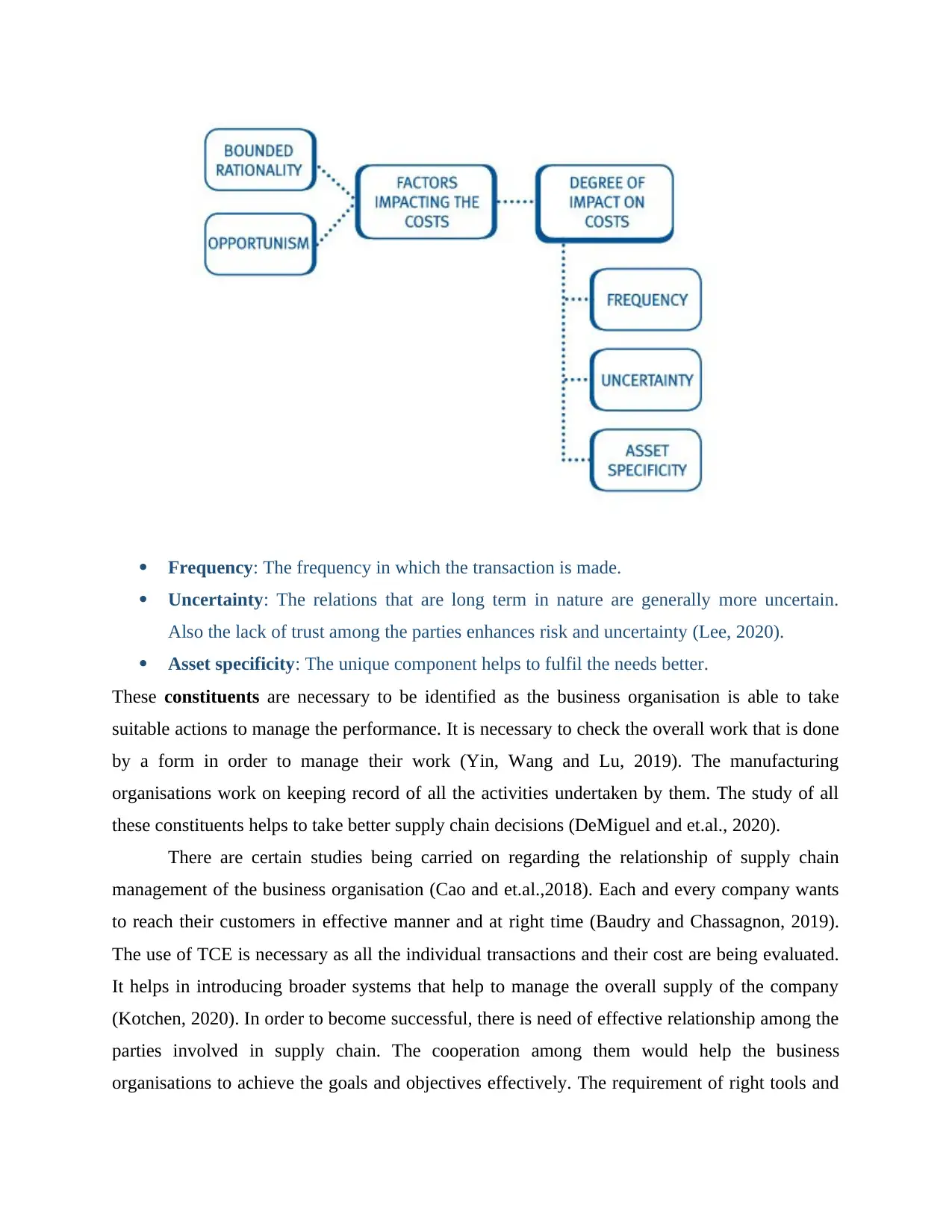
Frequency: The frequency in which the transaction is made.
Uncertainty: The relations that are long term in nature are generally more uncertain.
Also the lack of trust among the parties enhances risk and uncertainty (Lee, 2020).
Asset specificity: The unique component helps to fulfil the needs better.
These constituents are necessary to be identified as the business organisation is able to take
suitable actions to manage the performance. It is necessary to check the overall work that is done
by a form in order to manage their work (Yin, Wang and Lu, 2019). The manufacturing
organisations work on keeping record of all the activities undertaken by them. The study of all
these constituents helps to take better supply chain decisions (DeMiguel and et.al., 2020).
There are certain studies being carried on regarding the relationship of supply chain
management of the business organisation (Cao and et.al.,2018). Each and every company wants
to reach their customers in effective manner and at right time (Baudry and Chassagnon, 2019).
The use of TCE is necessary as all the individual transactions and their cost are being evaluated.
It helps in introducing broader systems that help to manage the overall supply of the company
(Kotchen, 2020). In order to become successful, there is need of effective relationship among the
parties involved in supply chain. The cooperation among them would help the business
organisations to achieve the goals and objectives effectively. The requirement of right tools and
Uncertainty: The relations that are long term in nature are generally more uncertain.
Also the lack of trust among the parties enhances risk and uncertainty (Lee, 2020).
Asset specificity: The unique component helps to fulfil the needs better.
These constituents are necessary to be identified as the business organisation is able to take
suitable actions to manage the performance. It is necessary to check the overall work that is done
by a form in order to manage their work (Yin, Wang and Lu, 2019). The manufacturing
organisations work on keeping record of all the activities undertaken by them. The study of all
these constituents helps to take better supply chain decisions (DeMiguel and et.al., 2020).
There are certain studies being carried on regarding the relationship of supply chain
management of the business organisation (Cao and et.al.,2018). Each and every company wants
to reach their customers in effective manner and at right time (Baudry and Chassagnon, 2019).
The use of TCE is necessary as all the individual transactions and their cost are being evaluated.
It helps in introducing broader systems that help to manage the overall supply of the company
(Kotchen, 2020). In order to become successful, there is need of effective relationship among the
parties involved in supply chain. The cooperation among them would help the business
organisations to achieve the goals and objectives effectively. The requirement of right tools and
⊘ This is a preview!⊘
Do you want full access?
Subscribe today to unlock all pages.

Trusted by 1+ million students worldwide
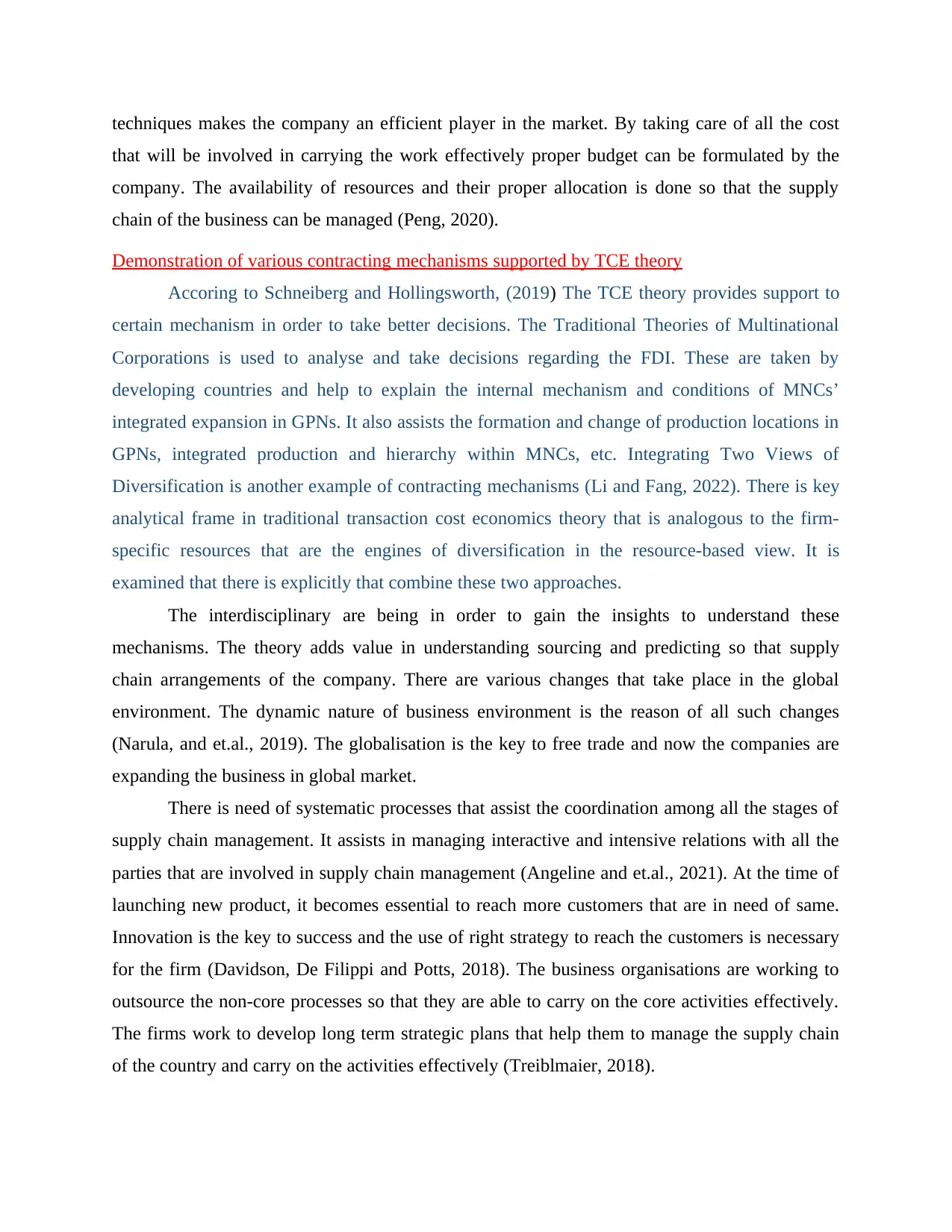
techniques makes the company an efficient player in the market. By taking care of all the cost
that will be involved in carrying the work effectively proper budget can be formulated by the
company. The availability of resources and their proper allocation is done so that the supply
chain of the business can be managed (Peng, 2020).
Demonstration of various contracting mechanisms supported by TCE theory
Accoring to Schneiberg and Hollingsworth, (2019) The TCE theory provides support to
certain mechanism in order to take better decisions. The Traditional Theories of Multinational
Corporations is used to analyse and take decisions regarding the FDI. These are taken by
developing countries and help to explain the internal mechanism and conditions of MNCs’
integrated expansion in GPNs. It also assists the formation and change of production locations in
GPNs, integrated production and hierarchy within MNCs, etc. Integrating Two Views of
Diversification is another example of contracting mechanisms (Li and Fang, 2022). There is key
analytical frame in traditional transaction cost economics theory that is analogous to the firm-
specific resources that are the engines of diversification in the resource-based view. It is
examined that there is explicitly that combine these two approaches.
The interdisciplinary are being in order to gain the insights to understand these
mechanisms. The theory adds value in understanding sourcing and predicting so that supply
chain arrangements of the company. There are various changes that take place in the global
environment. The dynamic nature of business environment is the reason of all such changes
(Narula, and et.al., 2019). The globalisation is the key to free trade and now the companies are
expanding the business in global market.
There is need of systematic processes that assist the coordination among all the stages of
supply chain management. It assists in managing interactive and intensive relations with all the
parties that are involved in supply chain management (Angeline and et.al., 2021). At the time of
launching new product, it becomes essential to reach more customers that are in need of same.
Innovation is the key to success and the use of right strategy to reach the customers is necessary
for the firm (Davidson, De Filippi and Potts, 2018). The business organisations are working to
outsource the non-core processes so that they are able to carry on the core activities effectively.
The firms work to develop long term strategic plans that help them to manage the supply chain
of the country and carry on the activities effectively (Treiblmaier, 2018).
that will be involved in carrying the work effectively proper budget can be formulated by the
company. The availability of resources and their proper allocation is done so that the supply
chain of the business can be managed (Peng, 2020).
Demonstration of various contracting mechanisms supported by TCE theory
Accoring to Schneiberg and Hollingsworth, (2019) The TCE theory provides support to
certain mechanism in order to take better decisions. The Traditional Theories of Multinational
Corporations is used to analyse and take decisions regarding the FDI. These are taken by
developing countries and help to explain the internal mechanism and conditions of MNCs’
integrated expansion in GPNs. It also assists the formation and change of production locations in
GPNs, integrated production and hierarchy within MNCs, etc. Integrating Two Views of
Diversification is another example of contracting mechanisms (Li and Fang, 2022). There is key
analytical frame in traditional transaction cost economics theory that is analogous to the firm-
specific resources that are the engines of diversification in the resource-based view. It is
examined that there is explicitly that combine these two approaches.
The interdisciplinary are being in order to gain the insights to understand these
mechanisms. The theory adds value in understanding sourcing and predicting so that supply
chain arrangements of the company. There are various changes that take place in the global
environment. The dynamic nature of business environment is the reason of all such changes
(Narula, and et.al., 2019). The globalisation is the key to free trade and now the companies are
expanding the business in global market.
There is need of systematic processes that assist the coordination among all the stages of
supply chain management. It assists in managing interactive and intensive relations with all the
parties that are involved in supply chain management (Angeline and et.al., 2021). At the time of
launching new product, it becomes essential to reach more customers that are in need of same.
Innovation is the key to success and the use of right strategy to reach the customers is necessary
for the firm (Davidson, De Filippi and Potts, 2018). The business organisations are working to
outsource the non-core processes so that they are able to carry on the core activities effectively.
The firms work to develop long term strategic plans that help them to manage the supply chain
of the country and carry on the activities effectively (Treiblmaier, 2018).
Paraphrase This Document
Need a fresh take? Get an instant paraphrase of this document with our AI Paraphraser
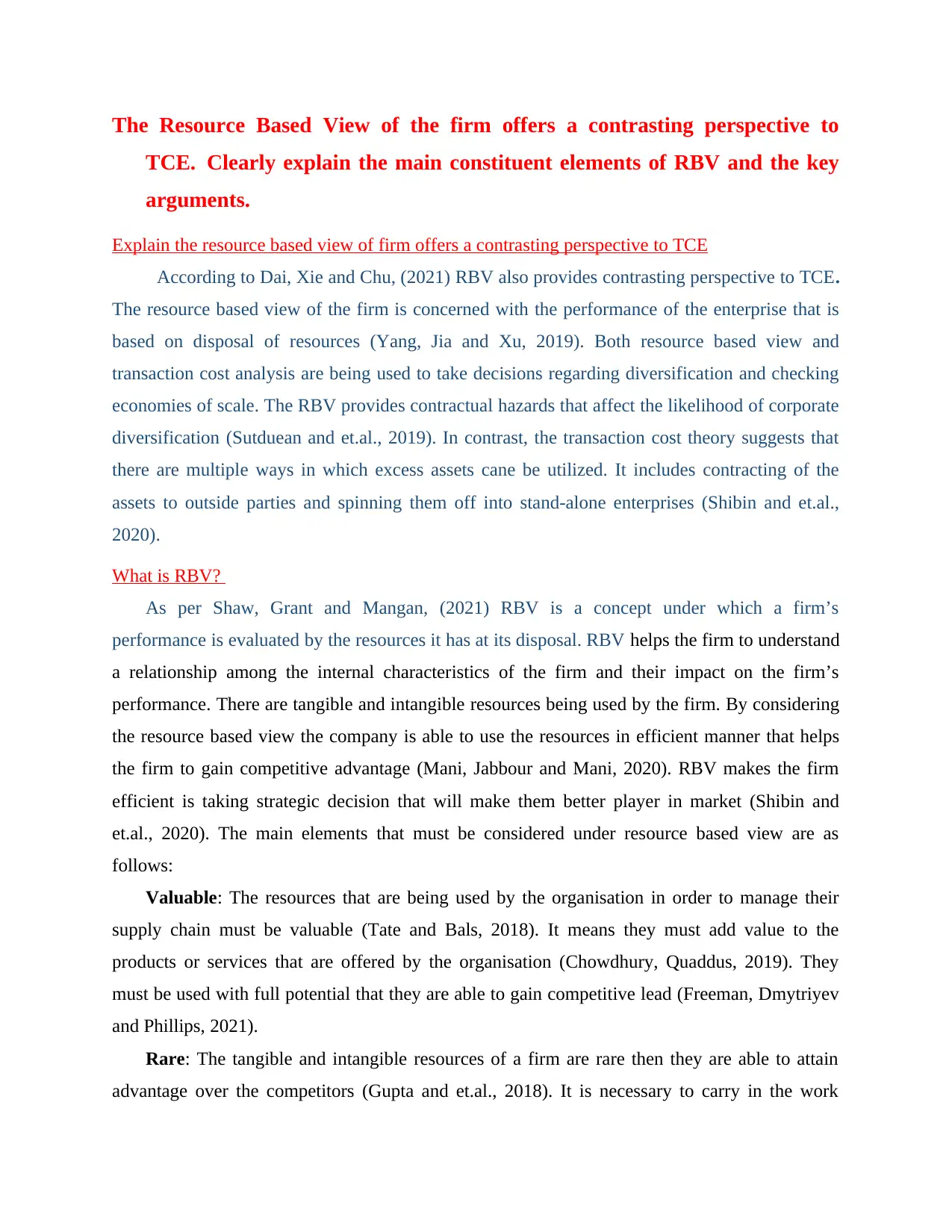
The Resource Based View of the firm offers a contrasting perspective to
TCE. Clearly explain the main constituent elements of RBV and the key
arguments.
Explain the resource based view of firm offers a contrasting perspective to TCE
According to Dai, Xie and Chu, (2021) RBV also provides contrasting perspective to TCE.
The resource based view of the firm is concerned with the performance of the enterprise that is
based on disposal of resources (Yang, Jia and Xu, 2019). Both resource based view and
transaction cost analysis are being used to take decisions regarding diversification and checking
economies of scale. The RBV provides contractual hazards that affect the likelihood of corporate
diversification (Sutduean and et.al., 2019). In contrast, the transaction cost theory suggests that
there are multiple ways in which excess assets cane be utilized. It includes contracting of the
assets to outside parties and spinning them off into stand-alone enterprises (Shibin and et.al.,
2020).
What is RBV?
As per Shaw, Grant and Mangan, (2021) RBV is a concept under which a firm’s
performance is evaluated by the resources it has at its disposal. RBV helps the firm to understand
a relationship among the internal characteristics of the firm and their impact on the firm’s
performance. There are tangible and intangible resources being used by the firm. By considering
the resource based view the company is able to use the resources in efficient manner that helps
the firm to gain competitive advantage (Mani, Jabbour and Mani, 2020). RBV makes the firm
efficient is taking strategic decision that will make them better player in market (Shibin and
et.al., 2020). The main elements that must be considered under resource based view are as
follows:
Valuable: The resources that are being used by the organisation in order to manage their
supply chain must be valuable (Tate and Bals, 2018). It means they must add value to the
products or services that are offered by the organisation (Chowdhury, Quaddus, 2019). They
must be used with full potential that they are able to gain competitive lead (Freeman, Dmytriyev
and Phillips, 2021).
Rare: The tangible and intangible resources of a firm are rare then they are able to attain
advantage over the competitors (Gupta and et.al., 2018). It is necessary to carry in the work
TCE. Clearly explain the main constituent elements of RBV and the key
arguments.
Explain the resource based view of firm offers a contrasting perspective to TCE
According to Dai, Xie and Chu, (2021) RBV also provides contrasting perspective to TCE.
The resource based view of the firm is concerned with the performance of the enterprise that is
based on disposal of resources (Yang, Jia and Xu, 2019). Both resource based view and
transaction cost analysis are being used to take decisions regarding diversification and checking
economies of scale. The RBV provides contractual hazards that affect the likelihood of corporate
diversification (Sutduean and et.al., 2019). In contrast, the transaction cost theory suggests that
there are multiple ways in which excess assets cane be utilized. It includes contracting of the
assets to outside parties and spinning them off into stand-alone enterprises (Shibin and et.al.,
2020).
What is RBV?
As per Shaw, Grant and Mangan, (2021) RBV is a concept under which a firm’s
performance is evaluated by the resources it has at its disposal. RBV helps the firm to understand
a relationship among the internal characteristics of the firm and their impact on the firm’s
performance. There are tangible and intangible resources being used by the firm. By considering
the resource based view the company is able to use the resources in efficient manner that helps
the firm to gain competitive advantage (Mani, Jabbour and Mani, 2020). RBV makes the firm
efficient is taking strategic decision that will make them better player in market (Shibin and
et.al., 2020). The main elements that must be considered under resource based view are as
follows:
Valuable: The resources that are being used by the organisation in order to manage their
supply chain must be valuable (Tate and Bals, 2018). It means they must add value to the
products or services that are offered by the organisation (Chowdhury, Quaddus, 2019). They
must be used with full potential that they are able to gain competitive lead (Freeman, Dmytriyev
and Phillips, 2021).
Rare: The tangible and intangible resources of a firm are rare then they are able to attain
advantage over the competitors (Gupta and et.al., 2018). It is necessary to carry in the work
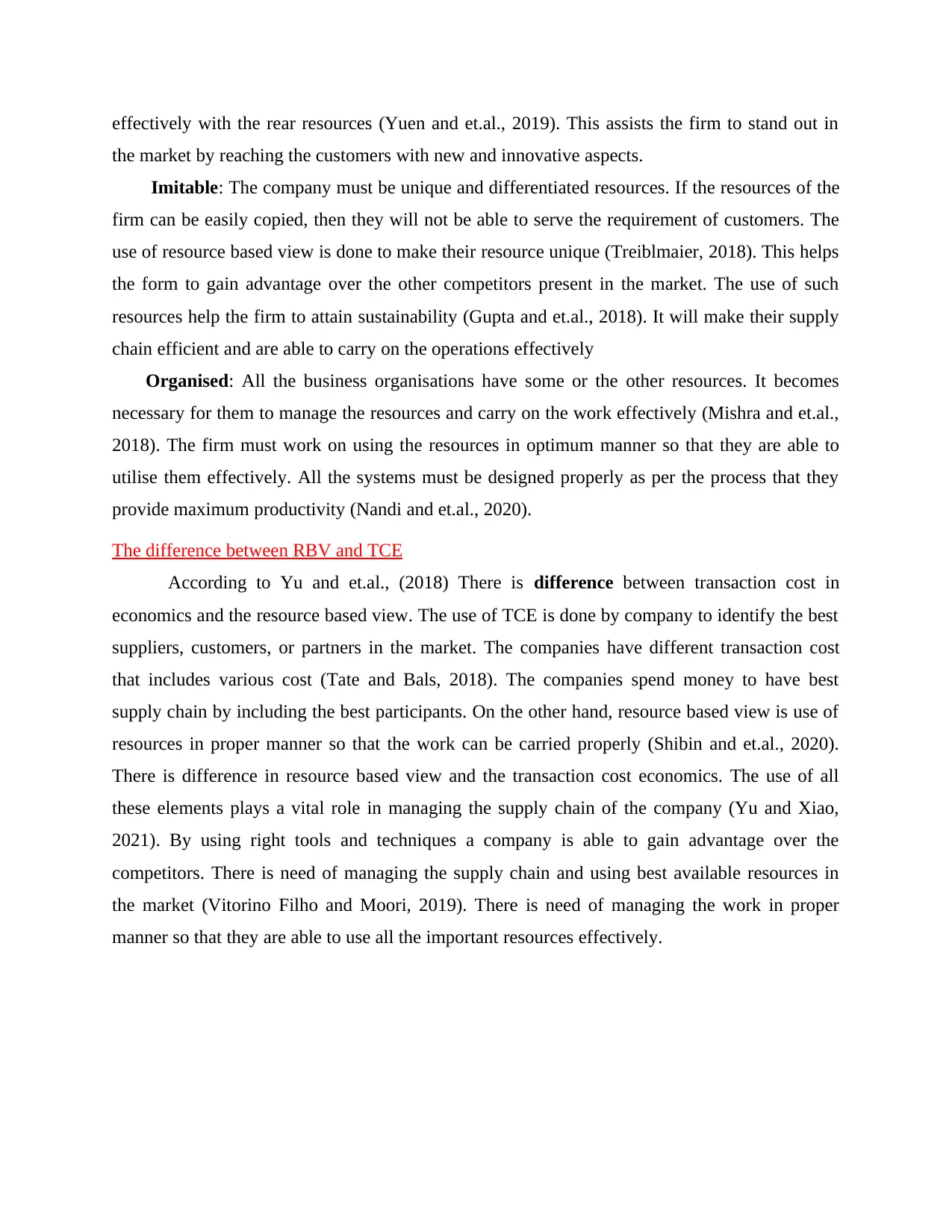
effectively with the rear resources (Yuen and et.al., 2019). This assists the firm to stand out in
the market by reaching the customers with new and innovative aspects.
Imitable: The company must be unique and differentiated resources. If the resources of the
firm can be easily copied, then they will not be able to serve the requirement of customers. The
use of resource based view is done to make their resource unique (Treiblmaier, 2018). This helps
the form to gain advantage over the other competitors present in the market. The use of such
resources help the firm to attain sustainability (Gupta and et.al., 2018). It will make their supply
chain efficient and are able to carry on the operations effectively
Organised: All the business organisations have some or the other resources. It becomes
necessary for them to manage the resources and carry on the work effectively (Mishra and et.al.,
2018). The firm must work on using the resources in optimum manner so that they are able to
utilise them effectively. All the systems must be designed properly as per the process that they
provide maximum productivity (Nandi and et.al., 2020).
The difference between RBV and TCE
According to Yu and et.al., (2018) There is difference between transaction cost in
economics and the resource based view. The use of TCE is done by company to identify the best
suppliers, customers, or partners in the market. The companies have different transaction cost
that includes various cost (Tate and Bals, 2018). The companies spend money to have best
supply chain by including the best participants. On the other hand, resource based view is use of
resources in proper manner so that the work can be carried properly (Shibin and et.al., 2020).
There is difference in resource based view and the transaction cost economics. The use of all
these elements plays a vital role in managing the supply chain of the company (Yu and Xiao,
2021). By using right tools and techniques a company is able to gain advantage over the
competitors. There is need of managing the supply chain and using best available resources in
the market (Vitorino Filho and Moori, 2019). There is need of managing the work in proper
manner so that they are able to use all the important resources effectively.
the market by reaching the customers with new and innovative aspects.
Imitable: The company must be unique and differentiated resources. If the resources of the
firm can be easily copied, then they will not be able to serve the requirement of customers. The
use of resource based view is done to make their resource unique (Treiblmaier, 2018). This helps
the form to gain advantage over the other competitors present in the market. The use of such
resources help the firm to attain sustainability (Gupta and et.al., 2018). It will make their supply
chain efficient and are able to carry on the operations effectively
Organised: All the business organisations have some or the other resources. It becomes
necessary for them to manage the resources and carry on the work effectively (Mishra and et.al.,
2018). The firm must work on using the resources in optimum manner so that they are able to
utilise them effectively. All the systems must be designed properly as per the process that they
provide maximum productivity (Nandi and et.al., 2020).
The difference between RBV and TCE
According to Yu and et.al., (2018) There is difference between transaction cost in
economics and the resource based view. The use of TCE is done by company to identify the best
suppliers, customers, or partners in the market. The companies have different transaction cost
that includes various cost (Tate and Bals, 2018). The companies spend money to have best
supply chain by including the best participants. On the other hand, resource based view is use of
resources in proper manner so that the work can be carried properly (Shibin and et.al., 2020).
There is difference in resource based view and the transaction cost economics. The use of all
these elements plays a vital role in managing the supply chain of the company (Yu and Xiao,
2021). By using right tools and techniques a company is able to gain advantage over the
competitors. There is need of managing the supply chain and using best available resources in
the market (Vitorino Filho and Moori, 2019). There is need of managing the work in proper
manner so that they are able to use all the important resources effectively.
⊘ This is a preview!⊘
Do you want full access?
Subscribe today to unlock all pages.

Trusted by 1+ million students worldwide
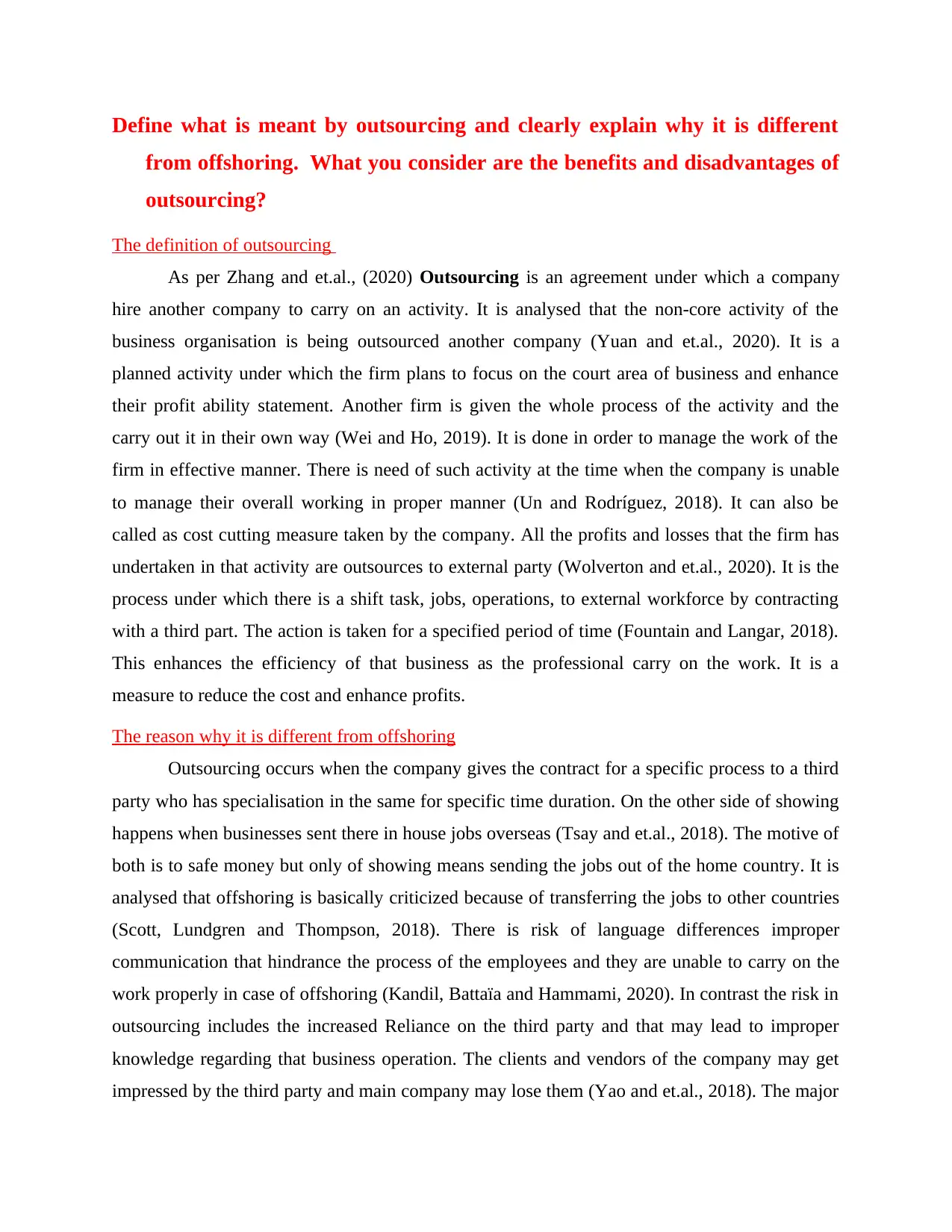
Define what is meant by outsourcing and clearly explain why it is different
from offshoring. What you consider are the benefits and disadvantages of
outsourcing?
The definition of outsourcing
As per Zhang and et.al., (2020) Outsourcing is an agreement under which a company
hire another company to carry on an activity. It is analysed that the non-core activity of the
business organisation is being outsourced another company (Yuan and et.al., 2020). It is a
planned activity under which the firm plans to focus on the court area of business and enhance
their profit ability statement. Another firm is given the whole process of the activity and the
carry out it in their own way (Wei and Ho, 2019). It is done in order to manage the work of the
firm in effective manner. There is need of such activity at the time when the company is unable
to manage their overall working in proper manner (Un and Rodríguez, 2018). It can also be
called as cost cutting measure taken by the company. All the profits and losses that the firm has
undertaken in that activity are outsources to external party (Wolverton and et.al., 2020). It is the
process under which there is a shift task, jobs, operations, to external workforce by contracting
with a third part. The action is taken for a specified period of time (Fountain and Langar, 2018).
This enhances the efficiency of that business as the professional carry on the work. It is a
measure to reduce the cost and enhance profits.
The reason why it is different from offshoring
Outsourcing occurs when the company gives the contract for a specific process to a third
party who has specialisation in the same for specific time duration. On the other side of showing
happens when businesses sent there in house jobs overseas (Tsay and et.al., 2018). The motive of
both is to safe money but only of showing means sending the jobs out of the home country. It is
analysed that offshoring is basically criticized because of transferring the jobs to other countries
(Scott, Lundgren and Thompson, 2018). There is risk of language differences improper
communication that hindrance the process of the employees and they are unable to carry on the
work properly in case of offshoring (Kandil, Battaïa and Hammami, 2020). In contrast the risk in
outsourcing includes the increased Reliance on the third party and that may lead to improper
knowledge regarding that business operation. The clients and vendors of the company may get
impressed by the third party and main company may lose them (Yao and et.al., 2018). The major
from offshoring. What you consider are the benefits and disadvantages of
outsourcing?
The definition of outsourcing
As per Zhang and et.al., (2020) Outsourcing is an agreement under which a company
hire another company to carry on an activity. It is analysed that the non-core activity of the
business organisation is being outsourced another company (Yuan and et.al., 2020). It is a
planned activity under which the firm plans to focus on the court area of business and enhance
their profit ability statement. Another firm is given the whole process of the activity and the
carry out it in their own way (Wei and Ho, 2019). It is done in order to manage the work of the
firm in effective manner. There is need of such activity at the time when the company is unable
to manage their overall working in proper manner (Un and Rodríguez, 2018). It can also be
called as cost cutting measure taken by the company. All the profits and losses that the firm has
undertaken in that activity are outsources to external party (Wolverton and et.al., 2020). It is the
process under which there is a shift task, jobs, operations, to external workforce by contracting
with a third part. The action is taken for a specified period of time (Fountain and Langar, 2018).
This enhances the efficiency of that business as the professional carry on the work. It is a
measure to reduce the cost and enhance profits.
The reason why it is different from offshoring
Outsourcing occurs when the company gives the contract for a specific process to a third
party who has specialisation in the same for specific time duration. On the other side of showing
happens when businesses sent there in house jobs overseas (Tsay and et.al., 2018). The motive of
both is to safe money but only of showing means sending the jobs out of the home country. It is
analysed that offshoring is basically criticized because of transferring the jobs to other countries
(Scott, Lundgren and Thompson, 2018). There is risk of language differences improper
communication that hindrance the process of the employees and they are unable to carry on the
work properly in case of offshoring (Kandil, Battaïa and Hammami, 2020). In contrast the risk in
outsourcing includes the increased Reliance on the third party and that may lead to improper
knowledge regarding that business operation. The clients and vendors of the company may get
impressed by the third party and main company may lose them (Yao and et.al., 2018). The major
Paraphrase This Document
Need a fresh take? Get an instant paraphrase of this document with our AI Paraphraser
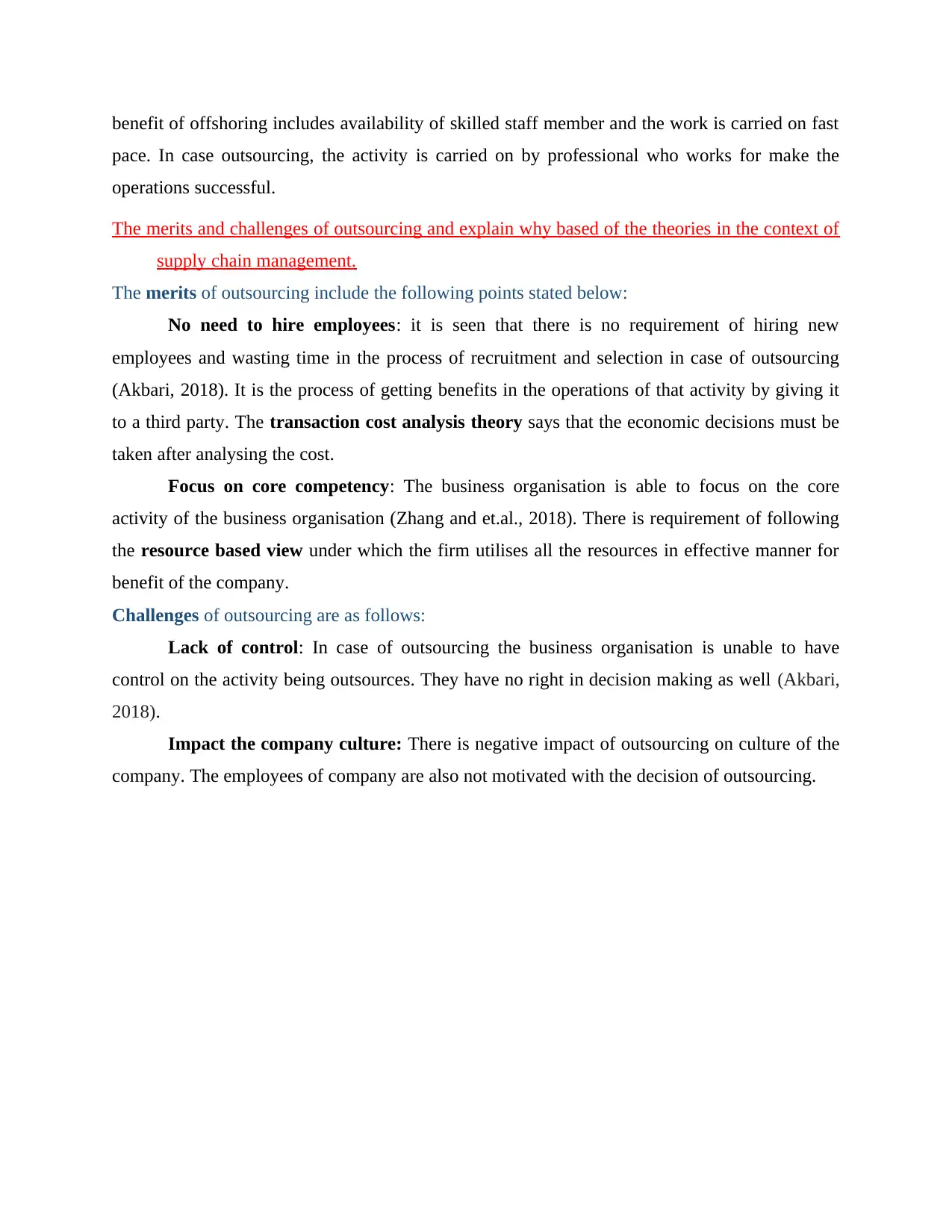
benefit of offshoring includes availability of skilled staff member and the work is carried on fast
pace. In case outsourcing, the activity is carried on by professional who works for make the
operations successful.
The merits and challenges of outsourcing and explain why based of the theories in the context of
supply chain management.
The merits of outsourcing include the following points stated below:
No need to hire employees: it is seen that there is no requirement of hiring new
employees and wasting time in the process of recruitment and selection in case of outsourcing
(Akbari, 2018). It is the process of getting benefits in the operations of that activity by giving it
to a third party. The transaction cost analysis theory says that the economic decisions must be
taken after analysing the cost.
Focus on core competency: The business organisation is able to focus on the core
activity of the business organisation (Zhang and et.al., 2018). There is requirement of following
the resource based view under which the firm utilises all the resources in effective manner for
benefit of the company.
Challenges of outsourcing are as follows:
Lack of control: In case of outsourcing the business organisation is unable to have
control on the activity being outsources. They have no right in decision making as well (Akbari,
2018).
Impact the company culture: There is negative impact of outsourcing on culture of the
company. The employees of company are also not motivated with the decision of outsourcing.
pace. In case outsourcing, the activity is carried on by professional who works for make the
operations successful.
The merits and challenges of outsourcing and explain why based of the theories in the context of
supply chain management.
The merits of outsourcing include the following points stated below:
No need to hire employees: it is seen that there is no requirement of hiring new
employees and wasting time in the process of recruitment and selection in case of outsourcing
(Akbari, 2018). It is the process of getting benefits in the operations of that activity by giving it
to a third party. The transaction cost analysis theory says that the economic decisions must be
taken after analysing the cost.
Focus on core competency: The business organisation is able to focus on the core
activity of the business organisation (Zhang and et.al., 2018). There is requirement of following
the resource based view under which the firm utilises all the resources in effective manner for
benefit of the company.
Challenges of outsourcing are as follows:
Lack of control: In case of outsourcing the business organisation is unable to have
control on the activity being outsources. They have no right in decision making as well (Akbari,
2018).
Impact the company culture: There is negative impact of outsourcing on culture of the
company. The employees of company are also not motivated with the decision of outsourcing.
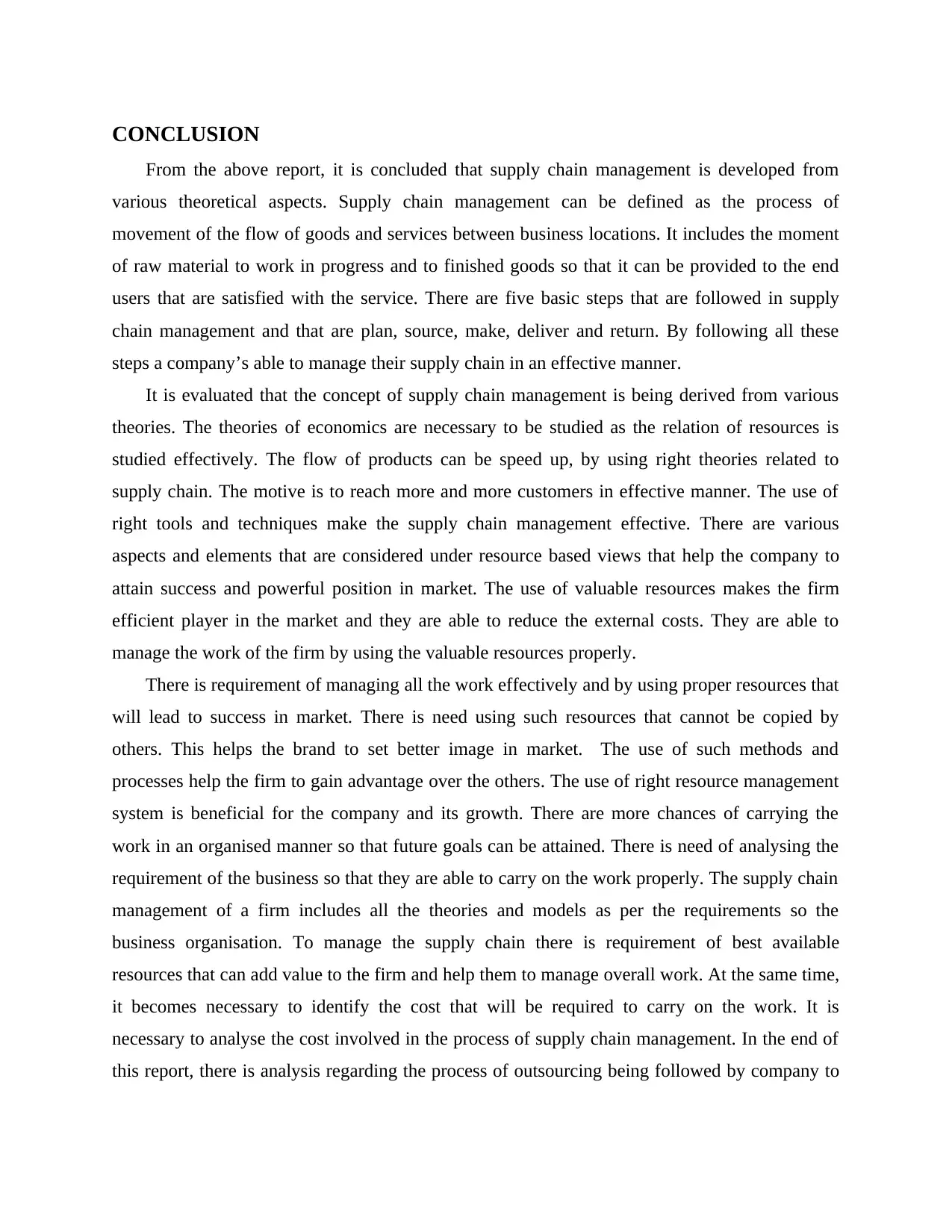
CONCLUSION
From the above report, it is concluded that supply chain management is developed from
various theoretical aspects. Supply chain management can be defined as the process of
movement of the flow of goods and services between business locations. It includes the moment
of raw material to work in progress and to finished goods so that it can be provided to the end
users that are satisfied with the service. There are five basic steps that are followed in supply
chain management and that are plan, source, make, deliver and return. By following all these
steps a company’s able to manage their supply chain in an effective manner.
It is evaluated that the concept of supply chain management is being derived from various
theories. The theories of economics are necessary to be studied as the relation of resources is
studied effectively. The flow of products can be speed up, by using right theories related to
supply chain. The motive is to reach more and more customers in effective manner. The use of
right tools and techniques make the supply chain management effective. There are various
aspects and elements that are considered under resource based views that help the company to
attain success and powerful position in market. The use of valuable resources makes the firm
efficient player in the market and they are able to reduce the external costs. They are able to
manage the work of the firm by using the valuable resources properly.
There is requirement of managing all the work effectively and by using proper resources that
will lead to success in market. There is need using such resources that cannot be copied by
others. This helps the brand to set better image in market. The use of such methods and
processes help the firm to gain advantage over the others. The use of right resource management
system is beneficial for the company and its growth. There are more chances of carrying the
work in an organised manner so that future goals can be attained. There is need of analysing the
requirement of the business so that they are able to carry on the work properly. The supply chain
management of a firm includes all the theories and models as per the requirements so the
business organisation. To manage the supply chain there is requirement of best available
resources that can add value to the firm and help them to manage overall work. At the same time,
it becomes necessary to identify the cost that will be required to carry on the work. It is
necessary to analyse the cost involved in the process of supply chain management. In the end of
this report, there is analysis regarding the process of outsourcing being followed by company to
From the above report, it is concluded that supply chain management is developed from
various theoretical aspects. Supply chain management can be defined as the process of
movement of the flow of goods and services between business locations. It includes the moment
of raw material to work in progress and to finished goods so that it can be provided to the end
users that are satisfied with the service. There are five basic steps that are followed in supply
chain management and that are plan, source, make, deliver and return. By following all these
steps a company’s able to manage their supply chain in an effective manner.
It is evaluated that the concept of supply chain management is being derived from various
theories. The theories of economics are necessary to be studied as the relation of resources is
studied effectively. The flow of products can be speed up, by using right theories related to
supply chain. The motive is to reach more and more customers in effective manner. The use of
right tools and techniques make the supply chain management effective. There are various
aspects and elements that are considered under resource based views that help the company to
attain success and powerful position in market. The use of valuable resources makes the firm
efficient player in the market and they are able to reduce the external costs. They are able to
manage the work of the firm by using the valuable resources properly.
There is requirement of managing all the work effectively and by using proper resources that
will lead to success in market. There is need using such resources that cannot be copied by
others. This helps the brand to set better image in market. The use of such methods and
processes help the firm to gain advantage over the others. The use of right resource management
system is beneficial for the company and its growth. There are more chances of carrying the
work in an organised manner so that future goals can be attained. There is need of analysing the
requirement of the business so that they are able to carry on the work properly. The supply chain
management of a firm includes all the theories and models as per the requirements so the
business organisation. To manage the supply chain there is requirement of best available
resources that can add value to the firm and help them to manage overall work. At the same time,
it becomes necessary to identify the cost that will be required to carry on the work. It is
necessary to analyse the cost involved in the process of supply chain management. In the end of
this report, there is analysis regarding the process of outsourcing being followed by company to
⊘ This is a preview!⊘
Do you want full access?
Subscribe today to unlock all pages.

Trusted by 1+ million students worldwide
1 out of 18
Your All-in-One AI-Powered Toolkit for Academic Success.
+13062052269
info@desklib.com
Available 24*7 on WhatsApp / Email
![[object Object]](/_next/static/media/star-bottom.7253800d.svg)
Unlock your academic potential
Copyright © 2020–2025 A2Z Services. All Rights Reserved. Developed and managed by ZUCOL.
